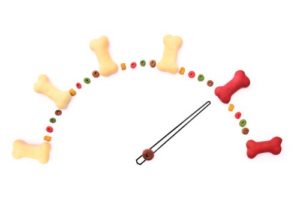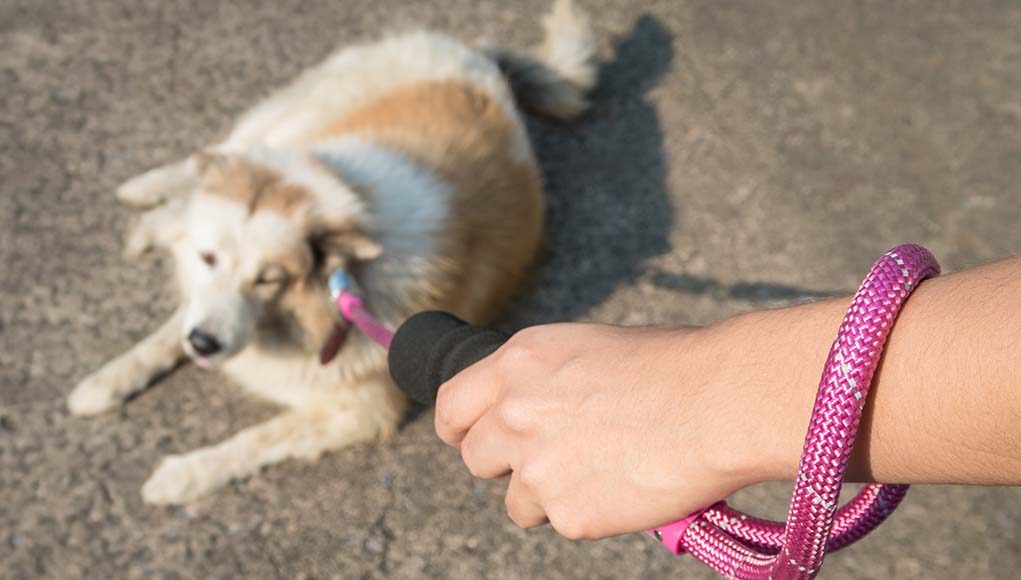Scientists say that it's very common for us to gain weight in winter. But humans aren't the only ones to get fatter during cold months. Dogs can put on winter fat just as easily as people, particularly because pet owners themselves become less active and don’t walk or play with their dogs.
Winter is a great time to let yourself enjoy the warm indoors with comfort food by your side and re-runs of “The Office,” but with Spring on the doorstep everybody's panicking about getting back in shape. While your Fido may be quite content with the extra layer of “skin”, you are likely very concerned over his bulky shape. So here are a few useful tips for getting your pooch back into top shape and into a beach-ready mode.
ALSO READ: The Best Weight Loss Dog Food for Overweight Dogs
1. Weigh Your Dog and Use BCS
Even if you don’t think that your dog gained a lot of weight, that might not be entirely true. Studies show that pet owners are very bad at telling the dog's proper weight. An eye test is rarely enough and can’t give you the full picture.
This is why you must weigh your dog and use the the Body Condition Score (PDF) guide. It's the easiest and most accurate way to tell if your pooch is overweight, underweight or is an perfect physical shape.
2. Measure Dog's Food Intake
 The best companion in your fight against the dog’s weight problem is a simple measuring cup. It's the equivalent of calorie counting for us, only much easier. If you are used to simply filling your dog’s bowl with kibble, or if you try to estimate how much is enough on your own, now is the time to start measuring for accurate portions.
The best companion in your fight against the dog’s weight problem is a simple measuring cup. It's the equivalent of calorie counting for us, only much easier. If you are used to simply filling your dog’s bowl with kibble, or if you try to estimate how much is enough on your own, now is the time to start measuring for accurate portions.
Evaluate how many calories your dog requires on a daily basis. Low fat dog food brands are often best to control calorie intake. This determines how much actual dog food he needs, volume-wise. Skip free feeding and opt for strictly portion-controlled meals.
All pet food companies are required to measuring amounts on their label. Going off that guidance is a great place to start. If your dog is significantly overweight, you can also ask your vet to help you make a 30 day diet plan based on your dog’s current weight and physical condition.
3. Cut Down on Dog Treats
You don't have to completely eliminate dog treats from your Fido's diet. But majority of popular commercial treats are full of filler ingredients and relatively high in calories. This makes treats a dangerous adversary in trying to keep your dog’s energy intake down.
The best way to go is to choose low-calorie healthy dog treats, those without sugar, fillers and high in nutrients. Dog treats made from a small number of ingredients and that include meat or fish protein are best. Small amounts of other ingredients, like pumpkin, sweet potato or blueberries are also acceptable.
But the most important part is to count calories when giving your dog treats. They should never make up more than 10% of your dog's daily caloric requirement. Try to divide each dog treat piece into separate ones. Your dog won’t notice the lack of substance, yet will be happy for the reward.
ASK A VET: How to Put an Overweight Dog on a Diet?
4. Beware of the Carbs
 Most dogs don’t even need a diet high in carbohydrates, even though that's a common way for many pet owners to feed dogs with pet food containing large amounts of carbs. When you take a closer look at your dog's food label, they often contain least 40-60% of carbs, which is true for majority of brands.
Most dogs don’t even need a diet high in carbohydrates, even though that's a common way for many pet owners to feed dogs with pet food containing large amounts of carbs. When you take a closer look at your dog's food label, they often contain least 40-60% of carbs, which is true for majority of brands.
Carbs are responsible for weight gain. The truth is that unless your dog has a specific condition that requires a high-carbohydrate diet, you should change his meals to prioritize protein, followed by fat. These two will replace carbs as the energy source for your dog and it will help him melt adipose tissue, in combination with regular physical activity.
5. Vegetables Can Help With Weight Loss
Vegetables are a healthy alternative to highly-processed treats from the store. Moreover, majority of vegetables contain higher amounts of fiber, which helps to keep your dog feeling full, assist with weight management and provide many health benefits. You can mix them into your dog's food, or give separately instead of a processed dog treat.
There are plenty of options to choose from: baby carrots, green beans, broccoli, cucumbers, celery and more. Fruits are also acceptable but they're not as beneficial as veggies. When feeding fruit, be mindful of natural sugars, smaller fiber content and higher caloric amount. Blueberries, apples and bananas are good is small amounts.
6. Extend Your Daily Walks
 Now that the winter is over, you don’t have any excuse to avoid walking your dog more (and exercising yourself). When it's cold, walking dogs in winter can be problematic, but as the weather gets better, try to extend your walks by 10, 20 or even 30 minutes.
Now that the winter is over, you don’t have any excuse to avoid walking your dog more (and exercising yourself). When it's cold, walking dogs in winter can be problematic, but as the weather gets better, try to extend your walks by 10, 20 or even 30 minutes.
Those few extra minutes of daily walking not only help both of you burn extra calories but can also boost your dog’s immune system, keep his behavior in check, prevent health and behavioral problems and improve cardiovascular health, among other benefits.
If you live somewhere like Seattle when it rains all the time, going out for long walks may not always be an option. Instead, try exercising with your pooch at home, or even get your dog a treadmill. That way you know exactly how often he will exercise, how many calories are burned and it's easier to create a routine for him. Most dogs love treadmills, too.
7. New Playtime Ideas
Playing with your pooch is the most enjoyable way for both of you to stay active, burn calories and get back in Spring shape. Go out for tried and tested activities like Frisbee, a game of fetch or chase, tug of war with toys or balls, or teaching your pooch new training tricks.
Coming up with new ideas for games you haven't tried before can be motivational for both for you to get out more often, and new types of exercise will also mentally stimulate your dog. Here are some ideas: hide and seek, Simon Says, basketball or soccer, treat hunt.
Mix things up and do some relaxed games at the dog park one day, and play sports with your pooch another time. If dog parks are a thing for you two, make it a priority to try and explore new places – you'll spend more time outside, socialize your dog and give him new experiences other than playing games.
8. Go Adventuring Together
 The best thing about Spring is that weather now allows more reasons to get outside and do outdoorsy things. When it comes to getting yourself and your pooch back in shape, nothing beats a full day of adventuring together. And there are plenty of things to try!
The best thing about Spring is that weather now allows more reasons to get outside and do outdoorsy things. When it comes to getting yourself and your pooch back in shape, nothing beats a full day of adventuring together. And there are plenty of things to try!
Go out hiking with your dog. Take a short one or two day travel trip to somewhere new, whether to explore the place or do some activities. Drive to the nearest lake or spend a day at the beach. Fishing, hunting, cycling, backpacking – tons of choices out there. Try going camping with your dog and include playtime in the woods.
9. Track Your Dog’s Progress
As you can see, there are plenty of things you can do to decrease your dog's calorie intake and increase his calorie burning, which will ultimately result in weight loss and finally get your pooch into tip top shape with a summer beach ready body. However, tracking your dog's progress is important too.
Monitoring and keeping an eye on any changes of your dog's weight and body shape will help you know whether you need to make some adjustments or stay the course. This is important both to keep the weight loss going, but also to not overdo with exercise and diet that would cause damage to your dog's health.
10. Stay Consistent, Firm and Disciplined
 Dogs are creatures of habit and changing this up much too often will cause them loose interest or even worse, cause stress for your dog. Once you develop a specific weight loss plan for your pooch that involves calorie restriction and exercise, keep it consistent so your Fido can adjust and get used to it gradually.
Dogs are creatures of habit and changing this up much too often will cause them loose interest or even worse, cause stress for your dog. Once you develop a specific weight loss plan for your pooch that involves calorie restriction and exercise, keep it consistent so your Fido can adjust and get used to it gradually.
Lack of willpower? If you need some motivation, read how this overweight dog lost all that excess fat, or how another dog helped an overweight man get back in shape and saved his life. Find more, as stories like these can help with staying motivated.
It's no secret that weight loss takes a lot of commitment and most of us struggle with that as well. Unfortunately, our pets can’t make a commitment on their own and we need to do it for them. You'll need to remain disciplined and invest some effort and time to get your dog back in shape.
READ NEXT: How to Help Your Senior Dog Lose Weight













